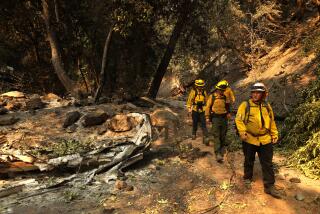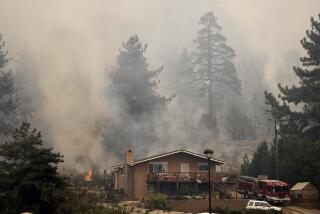Seattle-area bridge collapse severs an artery for holiday traffic
SEATTLE — Dan Sligh was on his way to a camping trip with his wife when he noticed the oversized truck in front of him on Interstate 5. It seemed about four feet too wide on the right side for the bridge they were approaching near Mount Vernon, Wash.
“I kept saying, ‘Anytime you want to move over to the left, it’d be OK,’” Sligh said. But just then, he said, another truck came up to the left of the oversize vehicle, and the wide load hit the approach spans to the four-lane bridge.
“There was a big puff of dust, and I hit the brakes. The forward momentum just carried us right over, and as you saw the water approaching, it was just one of those things — you hold on as tight as you can,” he said, describing “a white flash and cold water.”
PHOTOS: Bridge collapse in Washington
The collapse of a 160-foot span of the 1,111-foot steel-and-concrete bridge shortly after 7 p.m. Thursday sent two vehicles and a trailer into the river, triggering an urgent rescue effort as Sligh, his wife and another driver clung to their half-submerged vehicles.
All three were taken to hospitals. Sligh and the other driver were released, while Sligh’s wife, Sally Sligh, remained hospitalized Friday in stable condition.
The accident severed the West Coast’s main transportation artery 50 miles south of the Canadian border in advance of the Memorial Day weekend, when the route — which carries an average of 71,000 cars a day — typically explodes with vacationers.
“This is one of the busiest crossings in the entire United States, and if it’s closed, it will impact economic commerce between our two countries,” Sen. Maria Cantwell (D-Wash.) said in announcing that the federal Department of Transportation had made $1 million in emergency assistance available as a beginning step.
“There will be substantial delays,” Washington Gov. Jay Inslee warned. “We have something that we’re going to exhibit in considerable quantity in the next several weeks, several months, and that is patience.”
PHOTOS: Bridge collapse in Washington
State officials reported about 40-minute delays for traffic navigating the main surface road detour just east of the stricken bridge. Engineers were looking for alternative detours that could help spread traffic across all four bridges that span the Skagit River within 10 miles of I-5.
The immediate plan is to find a temporary bridge that could replace the broken 160-foot span, Inslee said. That could allow reopening the interstate in a matter of weeks. But if it proves necessary to rebuild the missing section instead, the delay could extend months, he said.
National Transportation Safety Board Chairwoman Deborah Hersman said the collapse was apparently triggered when the oversized tractor-trailer traveling south struck the overhead truss superstructure of the bridge.
The 58-year-old bridge is listed as “functionally obsolete” in the National Bridge Inventory, with “somewhat better than minimum adequacy to tolerate being left in place as is.” It received a sufficiency rating of 57.4 out of 100.
Across Washington, there were 394 structurally deficient bridges as of 2010, with 95% of the state’s bridges rated as good or fair, and 152 in poor condition.
“Obviously, this is a bridge that has lived a very long life,” Hersman said. “But what we know about this bridge is that even though it’s advanced in age … it has been healthy throughout that life. [But] it is showing age, certainly.”
The condition of the nation’s aging bridge infrastructure has been a concern since 2007, when a bridge fell into the Mississippi River in Minnesota, killing 13 people. About a quarter of the nation’s bridges are structurally deficient or functionally obsolete, according to federal records, and an average of 25 bridges in the U.S. collapse each year.
“I think you can see with this bridge that if it had been built today, it would have been built to different design standards to make sure that there were accommodations for the kind of traffic that we’re seeing today,” Hersman said.
The Skagit River bridge, built in 1955, is designed without the redundancy built into many modern bridges; serious damage to one of the two main trusses could cause it to collapse, said Jiri Pertold, a senior bridge engineer with David Evans and Associates in Bellevue, Wash.
“Modern bridges, they would be designed to have more things damaged before the bridge would collapse,” he said.
The Skagit River bridge was inspected twice in 2012, most recently in November, and had repairs made last year to a different portion of the bridge after that section was also struck by a vehicle, state officials said.
But even new bridges of modern design can fail when hit hard, said Travis Phelps of the state Transportation Department. “If you have a large freight load traveling at freeway speeds and you strike a bridge, you’re going to do damage,” he said. “That could be a new bridge or an older bridge.”
The truck that apparently hit the bridge, operated by Mullen Trucking of Alberta, Canada, was hauling a large container shed designed to be part of an oil-drilling platform.
Ed Scherbinski, Mullen’s vice president, said the company had obtained an oversize permit from the state and had hired a flag vehicle to accompany the truck on its route to Vancouver, Wash, just north of Portland, Ore.
“What I’m hearing is he didn’t know that he did anything wrong. He looked in the rear-view mirror and saw the bridge coming down behind him,” Scherbinski said of the driver, who was given a routine alcohol test.
Theoretically, the truck should have had room to clear the bridge, said Lt. Jason Armstrong of the Washington State Patrol.
The load height was 15 feet 6 inches, and the bridge height in the middle of the lanes is 17 feet. “The bridge certainly had the capacity to carry that height, but it appears the truck was positioned a little bit too far to the right, by the shoulder,” he said.
The bridge was not low enough to require a low-height warning sign, state officials said. Once the oversize permit was issued, it was up to the hauler to determine whether the vehicle could safely travel the route, Phelps said.
“We kind of give them a general outlook of the route. It’s still the responsibility of the driver for ensuring your load can get from point A to point B and not hit an overpass,” he said.
It appeared that injuries were minimized because the vehicles on the bridge rode the concrete as it sank down to the water rather than plunging the full 50 feet into the river, which is about 15 feet deep near the bridge.
“They were both half-submerged, but there’s bridge material that’s underneath them that was basically keeping them from going completely into the water,” said Marcus Deyerin, spokesman for the Washington Incident Management Team.
Sligh said his shoulder was dislocated by the impact as the top of his pickup truck caved in and its windshield shattered. His wife was initially silent in the passenger seat as they sat in “belly-deep” water, he said.
“I popped my shoulder back in … and pulled her over to my side, which had less water.”
Sligh said he began talking with another driver who was climbing out of his small sport utility vehicle, and the two of them tried to determine whether anyone else had gone into the river.
“That was our biggest fear at that point — that somebody was submerged,” Sligh said.
By that time, rescue boats were arriving. His wife was quivering with shock and “semi-hysteric,” he said.
One of the divers climbed onto a piece of concrete wedged near the truck and, after several tries, pried open the passenger-side door, pulling both of them to safety.
“I’m blessed,” Sligh said. “I’m blessed to be alive today.”
More to Read
Sign up for Essential California
The most important California stories and recommendations in your inbox every morning.
You may occasionally receive promotional content from the Los Angeles Times.










